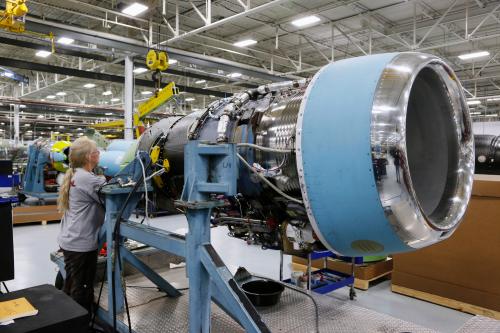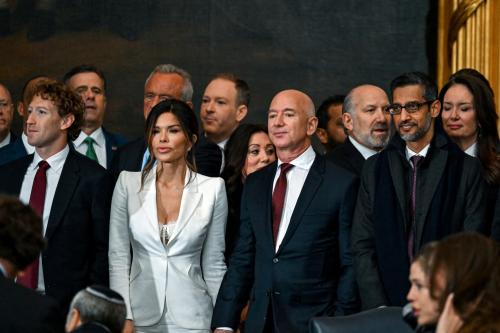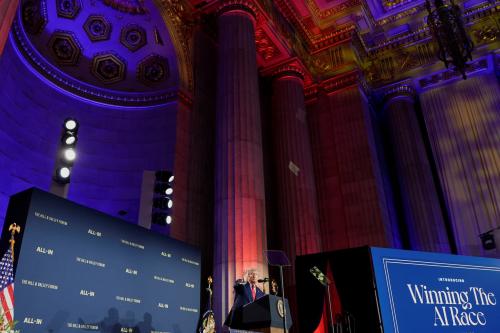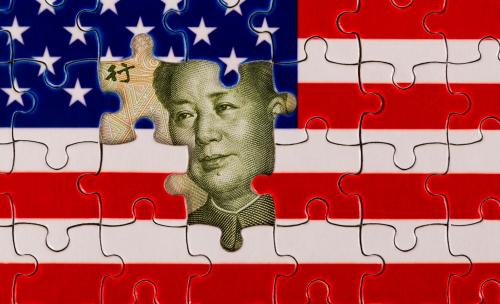President Donald Trump has promised to strengthen U.S. manufacturing and bring jobs back to the country. To do this, he has undertaken a number of initiatives, such as imposing tariffs on many different countries, cutting taxes, reducing regulations, and moving away from some clean energy standards, among other things. It is part of a pledge to “reindustrialize” America.
In doing so, the chief executive has followed the steps of other American presidents who tried to bring manufacturing back to the United States. President Joe Biden sought to restore U.S. advanced industries leadership through his Build Back Better initiative and the CHIPS and Science Act, which focused on various areas of advanced production, including semiconductor manufacturing. Likewise, President Barack Obama launched partnerships devoted to creating manufacturing jobs in artificial intelligence (AI), robotics, 3D printing, genomics, and material science.
At the six-month point in Trump’s presidency, what constitutes success in manufacturing and how should people assess his efforts? And what are the lessons from his actions on tariffs, trade, taxes, and energy? Brookings recently held its 14th annual John Hazen White Manufacturing Forum featuring experts who discussed these questions and explored various criteria for gauging the success of the president’s actions.
These metrics for manufacturing success metrics can gauge boosts in U.S. production jobs, increases in manufacturing output, gains in productivity, completion of trade agreements, reduced trade deficits, improved foreign investment, reductions in worker shortages, increased domestic components, shifts in the value of the dollar, and improvements in tariff revenues. We can use data from these measures to determine how successful Trump’s efforts have been and what to watch in coming months to determine whether his goals have been achieved.
Boosting US jobs
One of the most clearcut criteria for judging the success of Trump’s manufacturing initiatives will be the proportion of Americans employed in manufacturing. Figure 1 compiles monthly data on the total number of Americans employed in manufacturing from 1939 to 2025. The data indicates there were around 9.2 million employed in manufacturing in 1939. That figure reached a high of 19.5 million in 1979 but has declined to 12.8 million in 2025.
The problem is that the manufacturing employment numbers have been flat over the past six months since Trump’s inauguration and actually dropped by 7,000 from May to June. If one looks at the percentage of Americans employed in manufacturing, the share ran from around 30% in 1950 but now stands at just 8%. Each month, Americans will have data from the Bureau of Labor Statistics that offer insights into Trump’s ability to increase the number of manufacturing jobs, either in their total numbers or as a percentage of the workforce engaged in that sector.
Improvements in technology and widespread deployment of advanced technologies will be roadblocks to increasing manufacturing employment. Robotics, AI, and automation are all transforming manufacturing, and businesses around the world are finding it is possible to increase production with fewer workers. This is the case in China where some firms have launched fully autonomous “dark factories” where AI and robots assemble products. Between the advances in technology and the business incentives to use robots and AI to cut costs and increase profitability, it will be challenging for the Trump to deliver on his promise to bring jobs back to the country, likely to the disappointment of voters.
Raising manufacturing output
Manufacturing in the United States generates around $2.9 trillion to the economy. In looking at quarterly data from 1987 to 2025, output rose sharply in the 1980s and 1990s but has largely plateaued since. For the last decade or so, output surges during strong economies and declines during recessions, with little real increase in domestic output. Trump’s challenge here will be boosting manufacturing beyond the ebb and flow of economic cycles. Any financial downturn likely will reduce output, and it has been hard for many years to raise it beyond regular economic growth. To evaluate his success, people can judge the results of his manufacturing initiatives through government information released every quarter.
Increasing manufacturing productivity
Figure 3 shows the shifts in quarterly labor productivity (output per hour) in manufacturing from 2015 to 2025. With the exception of a large advance in the third quarter of 2020 a few months into the COVID-19 pandemic, the trend has been flat. There are small fluctuations of 1-2% but little long-term movement in labor productivity.
Going forward, there could be improvements in manufacturing productivity as emerging technologies move into the manufacturing sector. For example, there is “physical AI” that links robotics, sensors, and generative AI in ways that could make the sector more productive. However, given the lack of substantial productivity improvements in the past decade despite the introduction of robotics and AI, administration officials should be sanguine about progress on this metric.
Reducing trade deficits
Trump has complained about trade deficits with particular countries and sees his tariff impositions as a way to reduce them and therefore bring more manufacturing jobs back to the United States. Overall, in 2024, the United States had a $1.2 trillion trade deficit. Among the biggest deficits were China (-$295 billion), Mexico (-$172 billion), Vietnam (-$123 billion), Ireland (-$87 billion), and Germany (-$85 billion). If Trump were serious about reducing trade deficits, he could target these five nations,rather than imposing tarriffs on every country around the world. By tailoring tariffs and negotiations to those five nations, Trump would address about two-thirds of the overall trade deficit without souring relations with other trading partners.
Reaching trade agreements
As part of his policies to impose tariffs on foreign nations, Trump has announced a handful of agreements, such as with the European Union, United Kingdom and Vietnam. He has promised many more in coming weeks. But the U.K. agreement, for example, was with a country where the U.S. already had a trade surplus of $12 billion. The Vietnam agreement remains short on detail so it is hard to know how to evaluate its terms or longer-term impact, and whether it can reduce the trade deficit with that nation.
Improving foreign investment
Trump touts foreign investment in American manufacturing as a major step forward because it will lead to more U.S. factories, jobs, and economic output. He says many foreign companies such as Taiwan Semiconductor Manufacturing Company, Hyundai, Nissan, Honda, and Siemens have agreed to shift production to the United States.
Yet when reporters looked into the details of some of these announcements, they found several of the pronouncements included activities undertaken during the Biden administration, projects that the companies already have underway, or vague promises of future moves without much evidence of actual investment.
Rather than focusing on presidential announcements, a more reliable indicator would be to look at actual foreign investments. According to the Bureau of Economic Analysis, foreign direct investment totaled $2.2 trillion in 2023, and observers can monitor new data to see whether future investments rise beyond the ups and downs of the economic cycle.
Addressing shortages of US workers
There have been chronic shortages of manufacturing workers. In May 2025, there were 414,000 current vacancies in the sector, according to the National Association of Manufacturers. Over the next decade, the industry expects to need 3.8 million workers, with half of them likely to go unfilled based on current workforce projections.
It is not clear where the supply of new workers is going to come from. The Trump administration has dramatically cut federal support to community colleges and higher education. It has reduced support for university research across disciplines. And it is aggressively deporting immigrants and is seeking to scale back some types of legal immigration. Yet, manufacturing is one of the top sectors who rely on immigrant labor in the U.S., employing 3.2 million foreign-born workers. A national survey undertaken by the Cato Institute showed that 80% of Americans think more manufacturing would be good for the United States, but only 20% want to work in that field.
Increasing domestic components
Many would like to increase the percentage of domestic components that go into U.S. products. However, a shortage of crucial components from American sources hinders this goal. For example, it is hard to source materials such as steel, aluminum, copper, gallium and germanium used in semiconductors, and pharmaceuticals from the United States due to a lack of domestic capacity in these areas. Even if firms wish to ramp up their U.S. production, it is hard to turn on a dime and develop new supply chains over the course of a few months. Manufacturers cannot upend existing contracts and transportation networks overnight and find new suppliers. It takes a considerable amount of time to identify materials and components at an affordable price, which could come at the cost of innovation. High labor, energy, and environmental costs in the United States likely will challenge the ability of Trump to make or assemble many products here. In the future, researchers can see if his policies have increased the domestic components of U.S. products.
Shifting value of dollar
Another major variable for manufacturing is the value of the dollar. Right now, it has dropped more than 10% over the last six months. Manufacturing depends on the mix of imports versus exports. A declining dollar makes it more expensive to bring components into the United States but less expensive to sell goods to the rest of the world, therefore stimulating manufacturing to supply demands abroad. Large fluctuations in the value of our currency could have substantial ramifications for American manufacturers because it affects the cost of components imported from abroad as well as the ability to sell things overseas. The precise impact will vary quite a bit from sector to sector and company to company, but in general a weak dollar should improve exports and trade deficits, even if a long-term drop harms America’s overall prestige.
Raising tariff revenues
Trump claims tariff money is foreign revenue that comes into the federal government, but experts clarify that tariffs are taxes on importers, often American businesses, who then pass on the raised prices to U.S. consumers. Tariffs have often been used to incentivize domestic manufacturing as it increases the cost of imports. So far, tariffs have generated $126 billion for the U.S. government, but it is hard to determine whether this money constitutes a benefit or cost to the everyday consumer. If it is a tax, rising revenues is not a plus for American manufacturing, but rather just one more cost passed onto consumers.
The Brookings Institution is committed to quality, independence, and impact.
We are supported by a diverse array of funders. In line with our values and policies, each Brookings publication represents the sole views of its author(s).







Commentary
What constitutes manufacturing success?
July 31, 2025